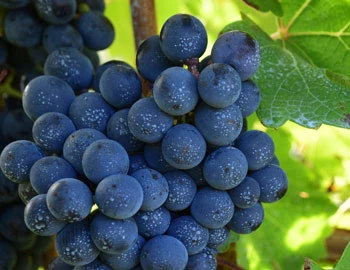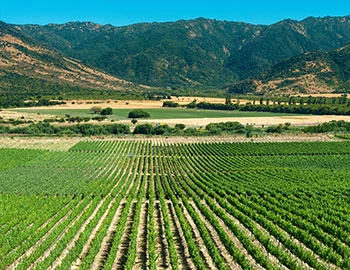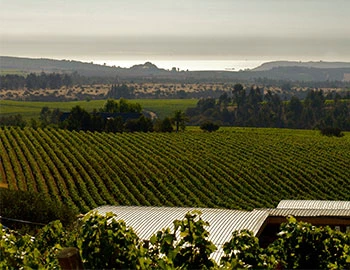Carmenère Azara 2020
Maule Valley, Terra Noble, 750 ml

| Grape variety: | Carmenere, Cabernet Sauvignon |
| Producer: | Viñedos Terranoble |
| Origin: | Chile / Valle Central / Maule |
Description
In the nose, the aromas of Carmenere are clearly reminiscent of dried figs, plums, coffee, and a hint of paprika. On the palate, it develops an intense structure, beautifully interwoven with a supple body, enhanced by barrique components. The Carmenere is a flattering, harmonious and silky Chilean red wine from the Maule Valley, south of the Andes in the foothills of the Central Valley. This textbook Carmenère, with its concentrated intensity power of the Chilean terroirs, will fascinate you! Best value for money.
Attributes
| Origin: | Chile / Valle Central / Maule |
| Grape variety: | Carmenere, Cabernet Sauvignon |
| Label: | Vegan |
| Ripening potential: | 1 to 6 years |
| Drinking temperature: | 16 to 18 °C |
| Food Pairing: | Châteaubriand, Filet Wellington, Wild specialities, Wild fowl, Cheese board |
| Vinification: | fermentation in steel tank, short must fermentation, fermentation at low temperatures |
| Maturation: | in new barriques |
| Maturation duration: | 20 months |
| Volume: | 14.0 % |
| Note: | Contains sulphites |
Cabernet Sauvignon
The backbone of Bordeaux
The Cabernet Sauvignon gives the Bordeaux its backbone, yielding deep violet wines with powerful tannins and endless ripening potential. It is the top dog in Médoc, and is placed in all five premier crus of Bordelais. When young, it often appears strict and unapproachable, but with advancing years, its tannins round off. It is wonderfully velvety, and yet always maintains its freshness. Typical flavours include cassis, graphite and cedar. Wherever Cabernet Sauvignon is found, Merlot is not far away. It complements the robust structure of Cabernet with softness, fruit and richness. The Cabernet Sauvignon is the most-exported vine in the world. It delivers persuasive qualities in Italy as an ingredient of the Super Tuscan, or as the flagship variety from California. There, it is lovingly titled “Cab Sauv”. Meat fans should be aware that it fantastically accompanies a grilled entrecôte. The family tree of Cabernet Sauvignon is surprising: its parents are Cabernet Franc and the white Sauvignon blanc.

Maule
Maule: the heart of Chilean viticulture
With a cultivation area of nearly 30,000 hectares, Chile's largest wine cultivation area is also the southernmost sub-region of the Valle Central. Situated roughly 250 kilometers south of the capital of Santiago, the Cabernet Sauvignon variety and the Chilean specialty, Carménère, demonstrate their excellent potential here. Spanish immigrants in Maule had already established the first vineyards in the 16th century. In the last 20 years, the trend has moved towards fruitier wines with slightly lower alcohol content.

Valle Central
Valle Central: the heart of Chilean viticulture
Valle Central comprises the four most important wine-growing areas in Chile. It starts in the southern outlying districts of the capital, Santiago, and stretches around 400 kilometres to the south, ending at the city of Parral. Red Bordeaux varieties occupy over 70 percent of total vineyard area. Depending on how strongly the particular microclimate is influenced by the cool influence of the Andes or the Pacific, stylistically varied wines result. Specialties like Carménère, Syrah and Carignan are gaining ground.

Chile
Chile – Where fortune came from tragedy
Wine-growing in Chile was born less out of economic reasons than lifestyle. Like the rest of the world, its aristocratic landowners admired everything that came out of France. They imitated French culture, built their haciendas in French architectural styles, and took trips to France. In 1851, the first French vines were brought back and formed the basis for producing quality wines.



